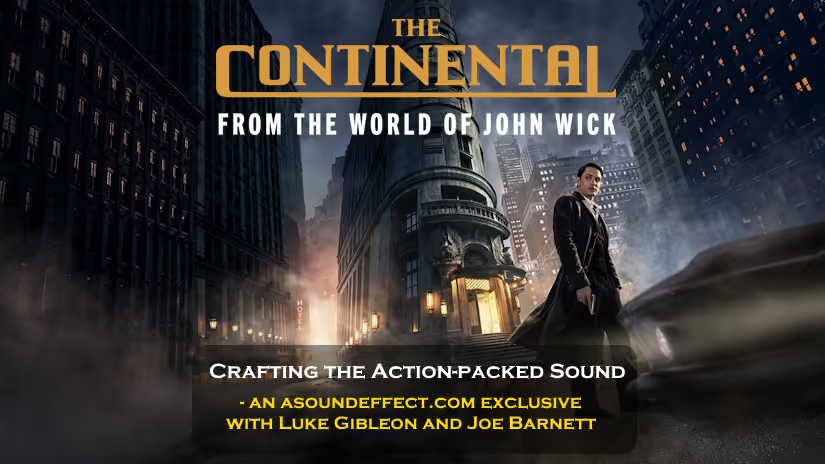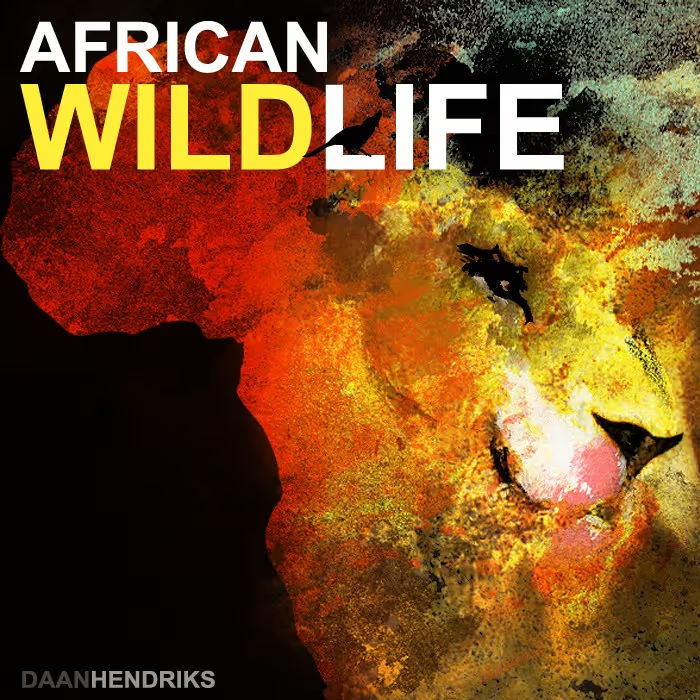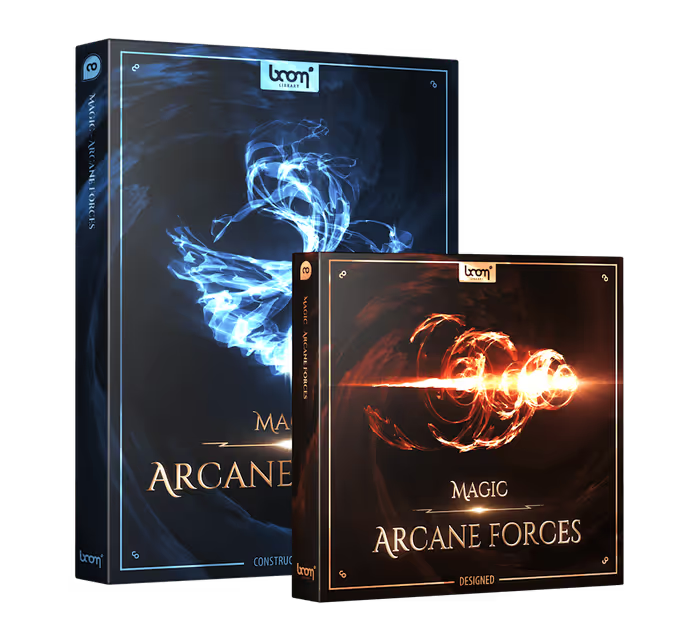(This is a spoiler-free interview)
There is something special about the sound of the fights in the John Wick films. Each gunshot punches you in the chest. Each punch knocks you back in your seat. The fights are as intense as they are inventive. Simply put, they’re fun!
And fun is exactly what the sound team had in mind for their work on Peacock’s streaming series The Continental: From the World of John Wick. Set in the ’70s, the story tells of Winston Scott’s rise to proprietor of assassin-haven “The Continental” in NYC. The showrunners use the music of the day to set the tone for the show, not only to establish the era but also to guide the sound design. Sound supervisor/sound designer Luke Gibleon, who has worked on the Wick films (particularly on the physical fights) received a ‘live’ spreadsheet of the licensed tracks during editorial, so each time a song was properly licensed, he knew he could spend time tuning the sound design to that song’s pitch and rhythm. This makes the songs and sound design fit hand-in-glove. And re-recording mixer Joe Barnett, who handled the dialogue and music, was able to play the songs prominently in the mix alongside the sound design. The show’s soundtrack moves and grooves, creating a unique action-packed experience that is fun and fierce.
Here, Formosa Group‘s Gibleon and Barnett share details on crafting the show’s sound in the Wick style while also making it distinct, how they fit the music and sound design together with such precision, how they used sound to tell the story during darkly-lit scenes, and much more!
The Continental: From the World of John Wick | Official Trailer | Peacock Original
Luke, you’ve worked on the John Wick films under the tutelage of Mark Stoeckinger and Alan Rankin. I absolutely love the sound of the guns and fighting in the John Wick films. How did that experience influence your approach to the guns in The Continental? How did you pay homage to the JW gun sound style? How did you make it your own?
Luke Gibleon (LG): I’ve been fortunate to work on every John Wick movie, starting as an apprentice on the first film, then as an effects editor on John Wick 2, a sound designer on John Wick 3, and I helped out on Wick 4, although I couldn’t help out as much as I would’ve liked because we were doing The Continental at the same time. I’m so grateful to have been a part of this world from the beginning. Learning from people as amazing and talented as Mark and Alan has made a significant impact on my growth as a sonic storyteller.
Working on The Continental wasn’t so much about making it my own, as it was about adapting the John Wick world to Albert Hughe’s vision. While the action and world-building are still there in all it’s Wick glory, the style of the filmmaking was quite different. Albert did a fantastic job bringing his own style to the show. He really played into edginess, transitions, and a love for making it feel like an immersive experience of this world in the 70’s.
Working on ‘The Continental’ wasn’t so much about making it my own, as it was about adapting the ‘John Wick’ world to Albert Hughe’s vision.
For a mini-series, there clearly couldn’t be as much action per episode as a John Wick film, though “Theater of Pain” is pretty close to the firstJohn Wick. So there were a lot of opportunities to do more immersive world-building, and bring new elements and design to this edgy style of Alber’s.
It was a lot of fun, and quite a bit of work! Albert is very into sound. He actually said that was something he thought about doing when he was a kid and making movies with his brother. So sound was very important to him, and it’s so wonderful to work with someone who has that kind of passion for sound.
The action, the gunplay, and the fighting in John Wick in general is something I like to call ‘precision violence.’ We’re very articulate. We’re very mindful of how we cut, design, and layer these guns. So they have that John Wick sound we love, but it also sounds natural to the world that it sits in. We like to be very careful in making sure it is specifically crafted for the John Wick world, so it’s not a different kind of fight and action choreography and sound design that we might use in a different action film.
I’ve constructed a lot of fights in the action movies I’ve worked on.
I’ve constructed a lot of fights in the action movies I’ve worked on. Often, that task is thrown on my shoulders so I have a pretty massive library that I continue to grow and I always try to add something new to it, as I did for The Continental based upon Albert’s taste and preferences.
Albert really loves the fight-impact sounds of older Indiana Jones movies. He loves the way those Impacts sounded so big and wide and full. So we were still crafting The Continental fights around his tastes and preferences, but it was also in combination with the Wick fight style. Nick Interlandi, the other sound designer on the show, also worked on John Wick 4 right before jumping into The Continental. He did a lot of work on the gunfights among other things.
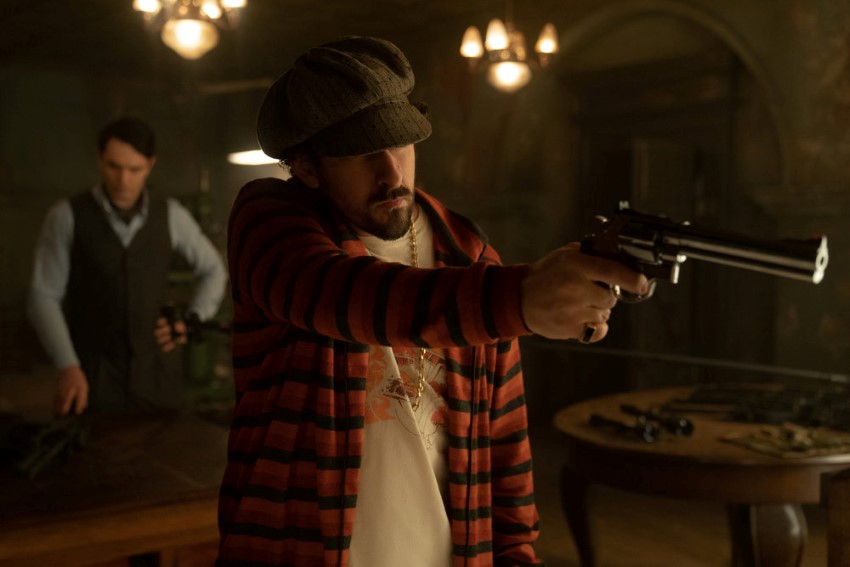
Since you’re designing this for TV, you probably weren’t able to punch the gun and fight impacts quite as hard as they’d be in a theatrical release. What were some of your workarounds for making the guns and punches sound impactful yet still hitting that streaming spec?
LG: A lot of help came from re-recording mixer Adam Jenkins, who mixed the effects. From day one of the mix, we were being mindful of how we transition that element that hits the sub.
And in editorial, I made sure we still included that sub layer but I also added an additional layer in the effects tracks so we were able to transition this low, tight impact across more of a broad-based spectrum. So even if we turned off the sub, we’d still get that same impact. We sat in the room together and did an A/B comparison of how it sounds theatrically and how it’s going to sound broadcast-wise, relying on Adam and Joe’s ears to make that transition smooth.
It wouldn’t happen without Luke’s precision editing of his precision violence.
Joe Barnett (JB): That is something we do on the stage for any of these big sequences. We play it without the sub (at least one pass) just to make sure it’s translating, and we check the additional delivery formats too. That also extends to all the other elements, like the interplay between the big sound effects and the music. It’s all got to play.
One of the other things that makes the guns so impactful is having room for them. If there’s a big scream that goes across a sound effect sequence, you need to cut it off. If there’s going to be an explosion or a gunshot, or if the music is bombastic, then it needs to clear up for a moment. It’s a little dance that we have to do every day, of who’s going to lead where, and that’s how all of these things get to play together.
Going back to Luke’s point about the precision violence, that is what makes this possible. Often, you’ll get a giant bag of effects and have to make it work, but the sounds don’t really play friendly in the sandbox with the other elements so it takes a whole lot more work. And given the schedule that we get for broadcast, it would be an impossible task. It wouldn’t happen without Luke’s precision editing of his precision violence.
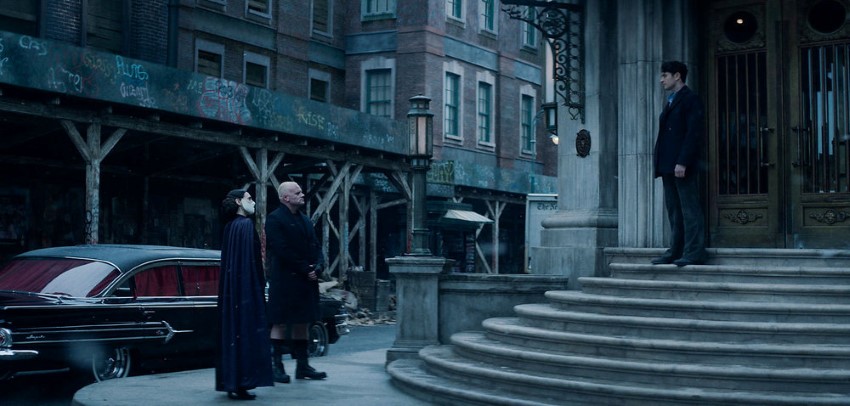
The licensed music in the show is awesome and plays a prominent role in the mix. Did you know about these tracks as you were doing sound editorial? What challenges (or opportunities) did they offer in terms of sound design?
LG: I did. And this was honestly one of my favorite things to design for in the show. We knew the needle drops were going to happen, and a lot of times with needle drops the filmmakers tend to want to back off of the effects and just let the music hit, but Albert [Hughes, director on several episodes] was so insistent on this being an experience where the music and sound work together. So, we didn’t have to drop the level of the effects so much. But in order to do that, you have to design the sound to work with these songs. The sounds have to be in rhythm and pitch with the songs being used.
To ease that process (because we are dealing with a broadcast timeline), they provided us with a live spreadsheet that would update every time the licensing got approved for one of these songs. At that point, we knew we could design to it.
…they provided us with a live spreadsheet that would update every time the licensing got approved…
There are so many instances of this in the show. In the first 10 minutes, we have the Salvation Army person ringing the bell in time to the Santana song and the car horns are honking in pitch with it. Then there’s this great negative accent of sound and the music just plays and has this wonderful moment but then the sound comes back in on the subway horn and that’s in pitch with an organ drone in the Santana song. And the subway doors are closing in rhythm with the Santana song.
 Tesla Model X 2015 electric full size crossover SUV sport utility vehicleKrampfstadt Studio65,00 $0,00 $100% OFF
Tesla Model X 2015 electric full size crossover SUV sport utility vehicleKrampfstadt Studio65,00 $0,00 $100% OFF
We got to do this throughout the show. One of my favorite examples is in “Night 3: Theater of Pain” with the song “One (is the Loneliest Number)” by Three Dog Night. There’s a cool elevator that’s moving differently than elevators usually move, and during the keyboard notes in the beginning of the song, we have the elevator sounds clanking along in time with that.
…Adam and Joe did a phenomenal job of mixing…and really making it work for the show.
We also designed steam going through these pipes in this back room. We used that sound to create a false rise with the phrase of the song that then continues to rise to the end of the phrase as the door opens. We did so much of that kind of work throughout the show and Adam and Joe did a phenomenal job of mixing that and really making it work for the show.
Adrian Medhurst and the foley team also did a great job hitting these musical moments.
JB: The thing about mixing the music and effects is that there’s got to be a space where they can play together. One of the things that Albert was saying the whole time is that you have to be bold with this stuff. “You can’t half-ass it. It’s got to be whole ass,” as he would say. So when George Thorogood comes on, it comes on hard. But then we back out of the way using EQ and spatial techniques so that it can all live on the screen.
Much of my time was spent doing very intricate volume maps of the dialogue so you could hear every single word…
But it’s an aggressive mix. You have all those elements working together but you still need to hear the words, too. Much of my time was spent doing very intricate volume maps of the dialogue so you could hear every single word but still feel the extreme action and bombastic music, so everything could work together. It was a lot of work and I’m really proud of the end result.
It was really stylistic, from top to bottom. We took our cues from Albert and there was a lot of special care given to the transitions between scenes. Luke created some cool transitions, like when it goes from the helicopter sequence directly into the spinning watch that Cormac O’Connor (Mel Gibson) is holding. Those are subtle details that everyone might not catch, but if you’re intently viewing it and you have a nice sound system at home, you’ll catch it. It’s pretty cool and not what you’d typically see in a streaming show.
The more decisions that you can make before the mix, the more intricate you can get in the mix…
Luke and Albert worked out a lot of ideas ahead of time. There’s no way we’d have time to re-edit sounds against the music on the stage. The more decisions that you can make before the mix, the more intricate you can get in the mix, but you have to have a clear vision from your creative head – in this case, Albert.
LG: That was a serendipitous combination, too. Be it Albert’s vision, or his editorial team of Ron Rosen and Armen Gasparian, they did an incredible job with the director’s cut, really laying out a map that helped us as far as hearing some ideas and then Albert asking us to push them to the extremes. So all those factors were working together.
There was a heavy load of great dialogue editing by my dialogue editor, Borja Sau Razquin.
Also, having worked on all the John Wick films, I already had fluency with the style and libraries of raw materials that we built. That gave us the extra time we needed to spend on crafting all of the different design ideas that Albert had for the show.
We also needed that time dialogue-wise too. There was a heavy load of great dialogue editing by my dialogue editor, Borja Sau Razquin. And then the amount of ADR and group ADR that we did was pretty significant for most shows. My ADR supervisor, Angelina Faulkner, did an amazing job, as well as our showrunner, Kirk Ward, who wrote a lot of group ADR lines, which a lot of showrunners usually don’t do.
So again, it was a really serendipitous combination of everybody contributing in a significant way.
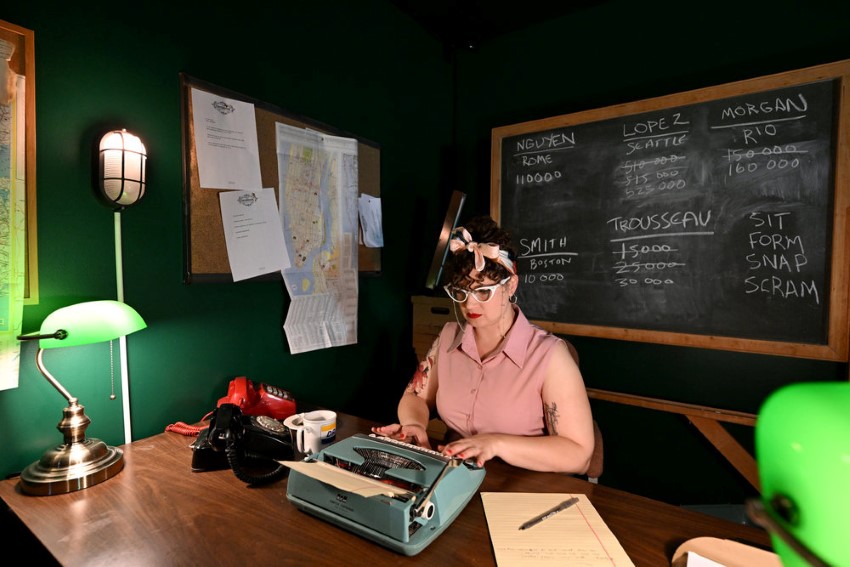
What went into the sound of The Continental hotel? Being that the show is set in the ’70s (instead of the current day as the movies are), how does it compare to how it sounds in the films? What are some of the sonic differences?
LG: There are some similarities and some differences. The world of John Wick itself is timeless. You see that in the way they use modern and analog devices throughout the films. So there’s that element of trying to make sure it felt timeless, but at the same time, we clearly couldn’t push beyond the period of the seventies.
We always had discussions about what technology was available at that point, and we only bent that rule when we got to the special secret room in The Continental that’s in “Night Three,” but even with that room, we thought about what sounds were used as sci-fi sounds in seventies films.
The world of ‘John Wick’ itself is timeless.
For other sounds within the hotel, we did what we like to do for the world of Wick, which is to use really interesting tones. We don’t want to just have room tone; we want to have a presence in the spaces, and sometimes that presence makes it feel like it’s breathing. Other times, it’s just an interesting tone.
The hotel itself has this great announcer voice they put together and these chimes occur right before the announcer voice. So those added elements are part of the sound of the hotel.
You can get in trouble if you’re just adding activity for activity’s sake…
From there, we just expanded on things. Albert was very insistent on the sound outside the hotel, especially New York City, being constantly alive, active, and busy. New York is the city that never sleeps. So it was very important to him that all of the spaces had an immersive sound to them. Again, he wanted this to be an experience, so it was that dance of trying to create an immersive experience with a lot of activity, but hopefully, when you pull it down in the mix, it would still feel active while allowing you to hear the dialogue. You can get in trouble if you’re just adding activity for activity’s sake thus creating a lot of mud. That’s where Adam and Joe did a fantastic job, mixing all that material to make it work.
JB: Piggybacking on that idea, the palette that Luke created for all the exterior sounds, and even when we’re in these interior spaces, was incredibly helpful when you’re telling the emotional story.
Negative space in a mix can be incredibly powerful…
Negative space in a mix can be incredibly powerful, so having all that sound there and being able to take it away at key points really heightens the intensity of the film or show. For instance, when one of the characters is about to get his head knocked in, all of that sound goes away, and you’re suddenly focused on the intense emotion between the two actors instead of thinking about the space. That was really cleverly done and was thought out way ahead of time, not just with sound, but with direction and blocking and editing and all those things as well.
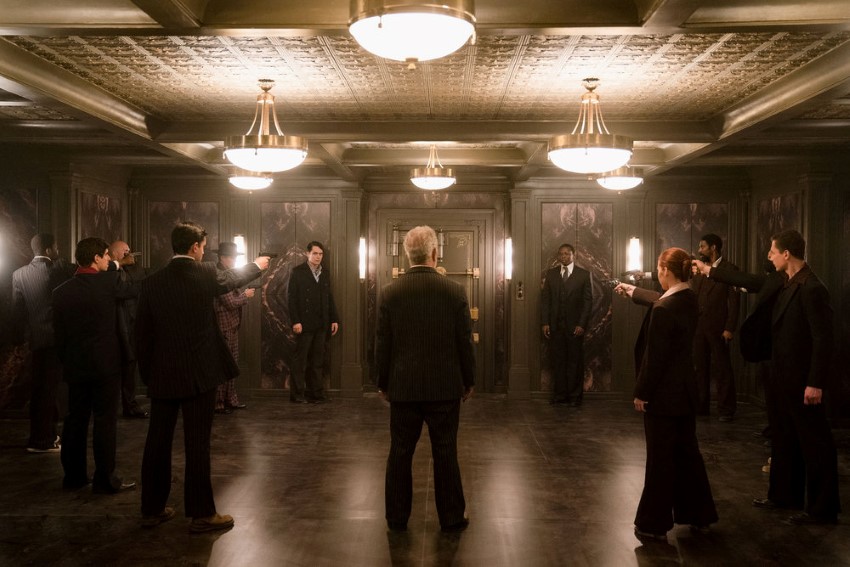
What’s been your biggest challenge creatively on The Continental?
LG: There were a lot of creative challenges. Albert’s vision being what it is, he loves to live in the edges and in transitions. He also loves to live in what he calls ‘blackness,’ where there are just frames of black and sound has to tell the story. A “Night Three” shootout happens in blackness, and that was a lot of work.
JB: I agree. That’s got to be the one.
…when you’re working in ‘blackness,’ it’s just sound that’s telling the story at this point.
LG: That was a major challenge because when you’re working in blackness, it’s just sound that’s telling the story at this point. You have to be very mindful to make sure that the story comes across; everything you’re doing with sound is helping to support the story, to tell the story, and to take the audience to where the director wants them to go. Sometimes it’s about directing people’s eyes to a certain place on-screen. Albert’s style is very edgy and transitionally you’re hitting all these little points, even light switches that would turn on were stylistically designed.
But I would definitely say the blackness parts were some of the most challenging places to work in because we’d only have a few seconds sometimes to tell the story to the audience about what was happening, and our sounds had to efficiently communicate that story.
JB: With that scene in “Night Three” in the blackness, when there’s this Mexican standoff moment between the good guys and the bad guys, we think we’ve got the drop on Cormac and the lights go out. The story that we’re trying to tell in those 8 to 10 seconds is pretty complex with no dialogue other than somebody screaming and a bunch of people getting shot. That was all Albert and he actually placed every single sound where he wanted it. Obviously, we mixed it and made it work, but for sure, it was a challenge.
…Albert was very aggressive with music – not just the intensity of it, but the way that it’s played.
Another challenge for me was that Albert was very aggressive with music – not just the intensity of it, but the way that it’s played. There were so many transitions. The music would play big and full and then play on a radio and then come from another room and transition to some other placement for it. If that stuff is not done tastefully, it gets really schlocky and gimmicky. And that’s the last thing we want.
Those music transitions were Albert’s direction too. He was our leader for sure with that stuff. The most important thing that we – as mixers on the stage – can ask of a client is just to have a vision to know what you want. If you have an idea of what you want ahead of time, that’s half the battle right there. Even in their temp track, they mocked up these things as rudimentary ideas of how the music should play, where sounds should be spatially, or how transitions should happen. Then we had to do a more sophisticated version of it. That made all the difference in the world.
LG: It was all foresight with him and his team – having that foresight and knowledge of what they were looking for. Knowing what they wanted for something that’s this active, immersive, and challenging sonically was very important. No doubt.
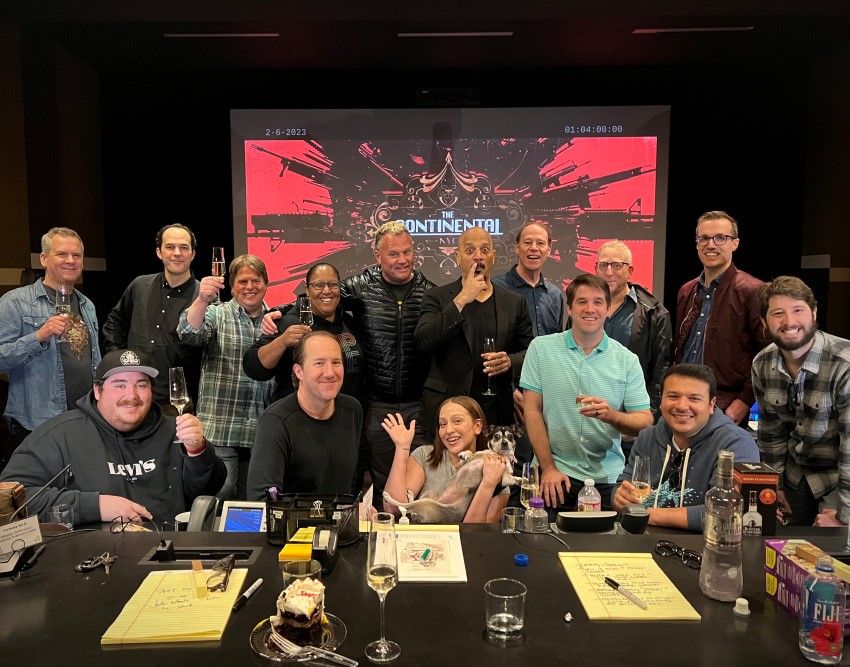
What would you want audiences to take away from the show in terms of sound? So as an episode ends, how do you want them to feel and how are you able to achieve that with the sound?
JB: For the very first playback we had of “Night One” with the studio execs, we played the show for them, the lights came up, and they could not believe what they just heard. They were absolutely stunned. All of the episodes are roughly an hour and a half long, so it’s a journey that the audience is going to take for each of these “Nights.” It’s just so much fun. And the fact that people couldn’t believe what they had just heard is the biggest compliment you could possibly pay to a sound team.
…Albert said he wanted this to be an experience above all. And that is what we hope we achieved for the audience.
LG: I agree wholeheartedly. From day one, Albert said he wanted this to be an experience above all. And that is what we hope we achieved for the audience. We tried to create this experience and give audiences the opportunity to walk away with a feeling of wow, that was fun.
We had a great time with that. That’s all I think Albert really wanted. This is just meant to be fun. And the world of John Wick is fun. From the beginning, it was meant to be this fun ride that we go on. That’s definitely what I hope people take away from it.
JB: We’re not curing cancer or solving world peace here. We’re just about having a really good time.
LG: We’re looking for a bit of escapism, to just have fun. And I think sometimes people lose sight of how important that can be when it comes to entertainment.
I’d like to shout out the sound crew on the show: sound designer Nick Interlandi, sound effects editor Joshua Adeniji, Angelina Faulkner, Borja Sau Razquin, and the foley team of Adrian Medhurst (foley artist) and Duncan Campbell (foley editor/ foley mixer), and to thank Formosa Group‘s Alan Rankin and Mark P. Stoeckinger who very much started the torch for the sound of the John Wick world.
JB: And a shout out to the mix team: Adam Jenkins (re-recording mixer) and Cameron Combe (re-recording mix technician).
A big thanks to Luke Gibleon and Joe Barnett for giving us a behind-the-scenes look at the sound of The Continental and to Jennifer Walden for the interview!
 Tesla Model X 2015 electric full size crossover SUV sport utility vehicleKrampfstadt Studio65,00 $0,00 $100% OFF
Tesla Model X 2015 electric full size crossover SUV sport utility vehicleKrampfstadt Studio65,00 $0,00 $100% OFF

